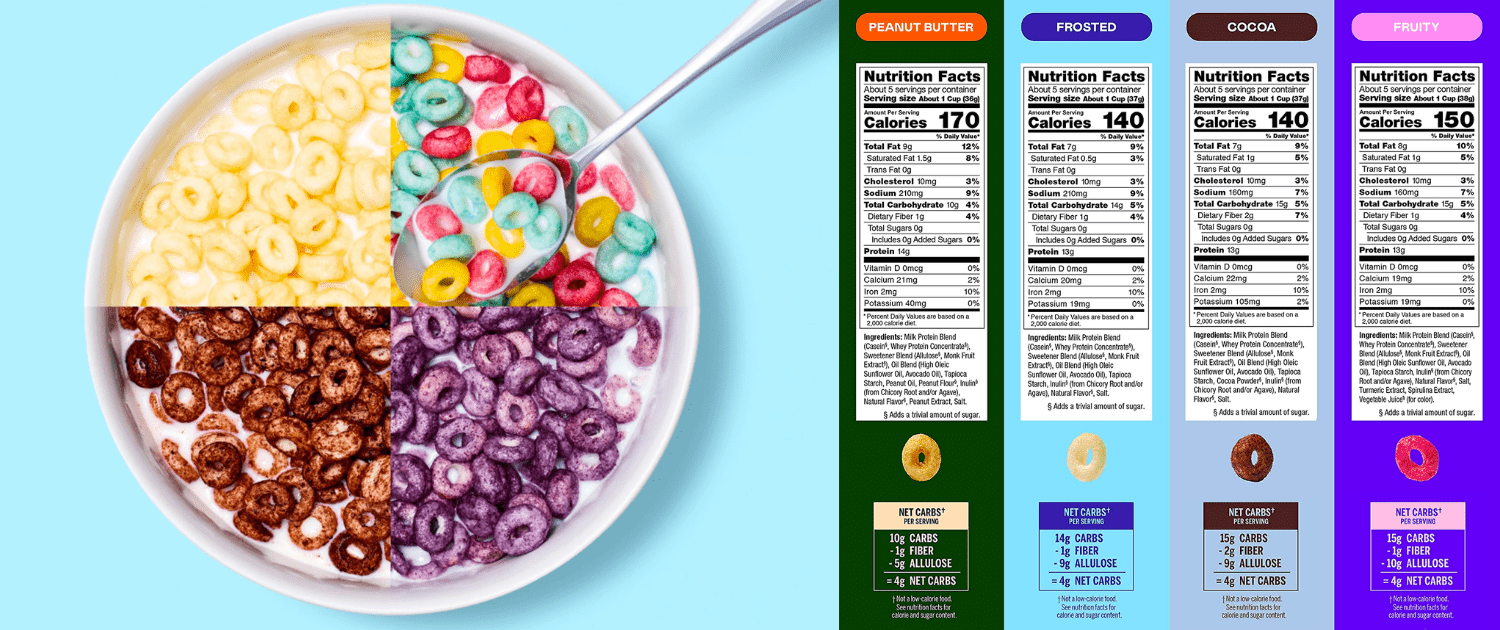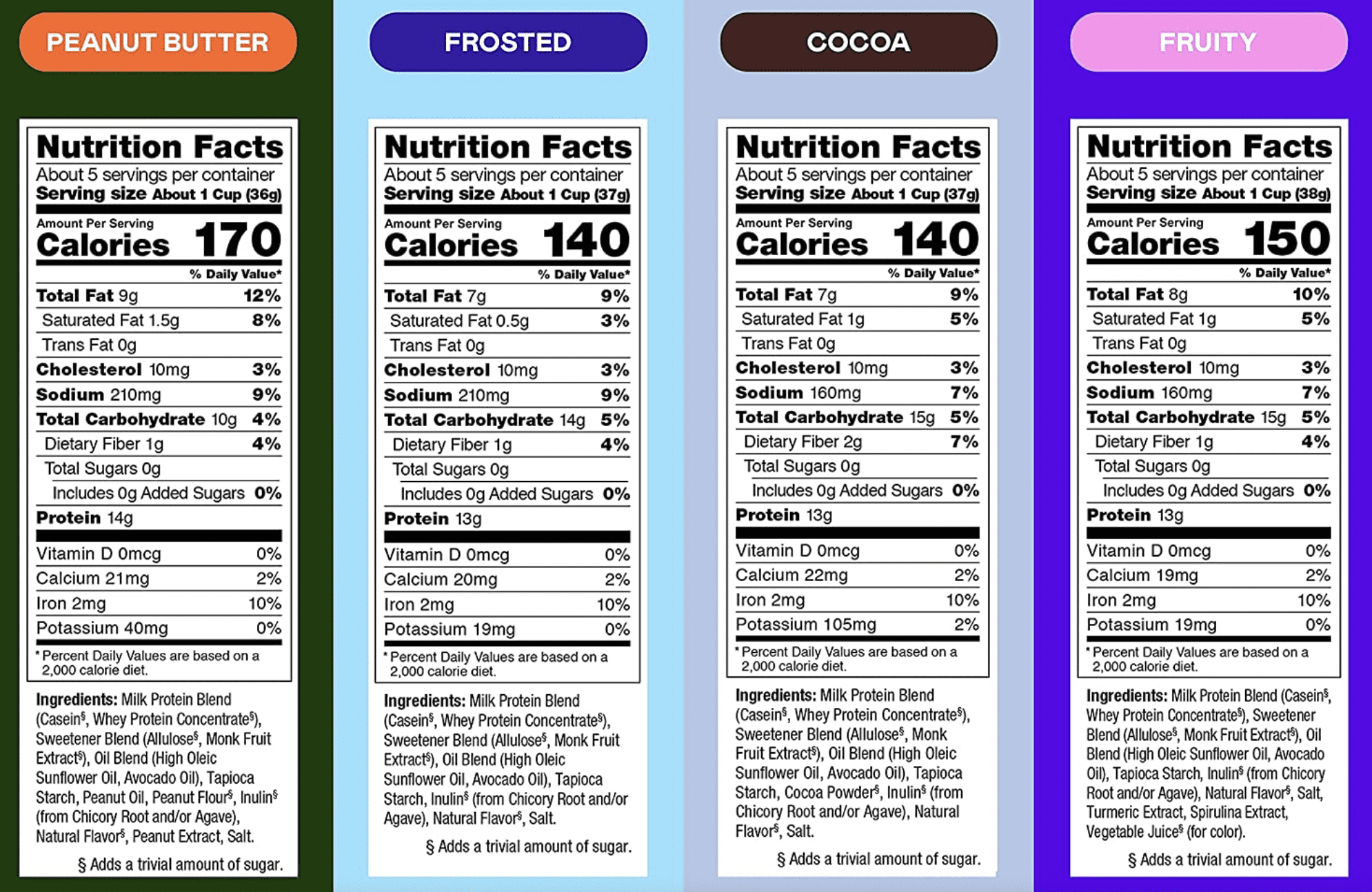What‘s the Deal With Magic Spoon Cereal? An RD’s Perspective…
Jan 16, 2021 by Brenna Wasylenki, RD, BSc. BEd.
Read time: 6 minutes
You may have heard about Magic Spoon, a company founded in 2019 making “healthy cereal that tastes too good to be true.”(1) This leaves me wondering, is it in fact too good to be true?
According to Magic Spoon, they have “reimagined all your favourite childhood cereals with only 4g net carbs, 13-14g complete protein, 140-170 calories and nothing artificial.”(1) Eight flavours are available to choose from including Fruity, Cocoa, Maple Waffle, and Peanut Butter. Now, as a dietitian, the first thing I tend to do when evaluating products is to look at the ingredient list and nutrition facts table. I’m going to that below; feel free to skip this, or skim it as you see fit.
Ingredient Breakdown:
The base ingredients listed are the same across all flavours and include: Milk Protein Blend, Sweetener Blend, Oil Blend, Tapioca Starch, Inulin, Natural Flavour, Salt. Let’s break these down a bit.
Milk Protein Blend
This is a combination of whey protein concentrate and casein. Whey and casein are the two proteins found in cow’s milk and are both complete proteins. Casein is considered a slower-acting protein because your body digests it much slower compared to whey which is digested much quicker.
Oil Blend
The oil blend is high-oleic sunflower oil and avocado oil or peanut oil in the peanut butter flavour. Sunflower oil contains linolenic acid which is an omega-6 polyunsaturated fatty acid. “High-oleic” just means the oil has a higher amount of oleic acid which is a type of monounsaturated fatty acid. High-oleic sunflower oil, avocado oil, and peanut oil are all considered heart-healthy oils(2).
Tapioca Starch
Tapioca starch is made from a starchy root called cassava and is naturally gluten-free. Because it is a starch, it contains very little protein, fat, or fibre.
Inulin
Magic Spoon uses inulin, a type of soluble fibre from either chicory root or agave. This soluble fibre is a prebiotic which helps feed our healthy gut bacteria.
Natural Flavour
Each of the flavours has additional ingredients like peanut extract, turmeric extract… you get the point. Compared to other sugary breakfast cereals the ingredient list contains relatively few ingredients and does not use artificial flavours or colours. However, in recent years, many cereal brands have started to shift towards using natural flavorings and colours. Now I mentioned earlier that the cereal has only 4g net carbs which are quite low for a breakfast cereal. Net carbohydrates are just another way of saying digestible carbohydrates which means the number of carbohydrates your body digests and uses for energy.
Sweetener Blend
Magic Spoon uses a “sweetener blend” made up of monk fruit extract and allulose. Allulose is a natural sugar found in maple syrup, figs, and raisins but contains about 90% fewer calories than table sugar per gram(3). Our body doesn’t end up using allulose for fuel, instead, it just ends up going to the toilet – as pee, and yes, poop(4). As an extra benefit, because allulose is not recognized as a fuel source by our body, it does not raise our blood sugar levels or insulin levels after we eat it(4).
Allulose has yet to be approved by Health Canada which is why you will not find it on Health Canada’s “List of Permitted Sweeteners”. It is however on the Generally Regarded As Safe list in the United States which is a designation given to substances added to food products that experts deem safe(5,6).
Emerging science has begun to show that allulose may have some benefits for type 2 diabetes and obesity. According to a 2018 study, researchers looked at whether allulose could reduce body fat, markers for diabetes, and blood cholesterol levels(7). The results showed that although individuals taking a beverage with a high dose of allulose did have a decrease in body fat mass, body fat percentage, and body mass index (BMI), there were no differences in blood cholesterol levels or diabetes markers when compared to a placebo group(7). As most of the research around allulose has been done using animal models, there is still more research needed to determine its health effects in humans.
Nutrient Facts Table:
The calorie content of Magic Spoon is comparable with other breakfast cereals however, Magic Spoon or not, most cereals have a listed serving size of ¾ or 1 cup. Next time you’re in your kitchen, hold up a 1 cup measuring scoop and be honest with yourself… do you eat more than 1 cup? I know I do!
Magic Spoon contains 13-14 grams of protein per serving which is one of the biggest benefits of this cereal. Protein has a satiating effect in our body meaning it will help you feel full. Fibre also has a satiating effect however Magic Spoon’s fibre content is quite low with only 1 gram per serving. Although the fat content in Magic Spoon is higher than comparable breakfast cereals, it’s primarily heart-healthy fats. Finally, another advantage of the Magic Spoon cereal is the fact that there is no added sugar which is a big difference to comparable breakfast cereals that can be very high in sugar.
The above all assumes that you eat a bowl of dry cereal so for argument’s sake, let’s say you eat it with milk. For this example, I chose 2% cow’s milk and we can see here how the nutrition profile is changed(10).
1 cup Magic Spoon Cereal with 1 cup 2% cows milk:
- Calories: 279
- Net Carbohydrates: 16.38 grams
- Fibre: 1 gram
- Sugar: 13.05 grams
- Protein: 22.51 grams
As mentioned earlier, Magic Spoon contains relatively few ingredients and that is due in part to the lack of fortification with micronutrients. In Canada, the Food and Drug Regulations set the framework for food fortification including mandatory fortification and voluntary fortification of foods(8). For example, margarine requires mandatory fortification of vitamin A & vitamin D whereas breakfast cereals can have voluntary fortification of the following nutrients: thiamine, niacin, vitamin B6, folic acid, pantothenic acid, magnesium, iron, zinc(9). Fortified breakfast cereals are large contributors to North American diets and can help people get key nutrients that may be lacking in their diet.
Price:
Another factor to consider when purchasing this cereal is the price. The cereal is shipped by the case (4 boxes or 20 total servings) and is $39.00 USD without shipping costs. Conversion rates differ daily but when I did my calculation today, that equaled $49.18 CAD without shipping!
When I grocery shop, I usually look at the $/g so if we factor that out in CAD, it means that this cereal costs $6.21/100g which is significantly different from a comparable breakfast cereal which costs around $1.20/100g at my local grocery store.
Below I have listed a few alternatives that would have a similar nutrition profile to the Magic Spoon Cereal with 2% cow’s milk, all less than $4.00 per serving(10):
2 egg and ½ cup bell pepper omelet with 1 cup milk:
- Calories: 295
- Net Carbohydrates: 16.08 grams
- Fibre: 1.6 grams
- Sugar: 16.15 grams
- Protein: 21.61 grams
½ cup oatmeal with 1 Tbsp peanut butter and 1 Tbsp hemp hearts:
- Calories: 237
- Net Carbohydrates: 15.13 grams
- Fibre: 3.33 grams
- Sugar: 1.63 grams
- Protein: 9.8 grams
½ cup 0%M.F. Greek Yogurt with 1 Tbsp hemp hearts and 1 cup frozen raspberries:
- Calories: 203
- Net Carbohydrates: 16.41 grams
- Fibre: 6.85 grams
- Sugar: 12.99 grams
- Protein: 16.41 grams
It’s often helpful to make a Pros and Cons list to help determine if it makes sense to buy and use this product, so let’s do that.
Pros
- 13-14 grams of protein per serving.
- No added sugar. This is a big difference to comparable breakfast cereals that can be very high in sugar.
- “Sweetener blend” does not raise blood sugar or insulin levels due to the presence of monk fruit extract and Allulose; caveat: Allulose hasn’t been approved by Health Canada yet.
Cons
- At $6.21/100g, compared to a typical breakfast cereal around $1.20/100g, this is quite expensive.
- Lack of Fortification with Micronutrients.
According to a discussion Mike had on Facebook earlier this summer, here is what some other people said:
- “Taste like you’re eating cardboard a bit”
- “It’s great if you eat it all in exactly 42.678 seconds of the milk touching it. Too soon and it’s like cardboard, seconds too late and it’s mush. Flavor is on point though, especially the fruit loop one.”
- “Omg I love it! I’m an addict. Almost more so than peanut butter.”
- “I got a variety pack. The frosted kind was
. But I loved the fruit loops knock off and chocolate one!”
Final Thoughts:
Looking at everything we’ve discovered so far, my advice is to skip the Magic Spoon Cereal for now. It is no secret that food prices have been steadily increasing in Canada which means that this cereal will be out of budget for most Canadians. Using ingredients you most likely already have in your house, you can make yourself a healthy, filling breakfast without breaking the bank. If you are craving one of your favourite childhood cereals, I believe the old adage of “everything in moderation” fits here. Have some, enjoy, and be mindful of your portion size.








